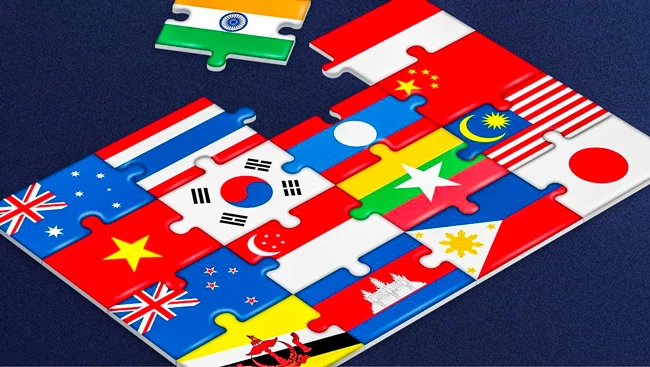
Afraid of Chinese goods
Making a forceful argument in his address at the summit, Indian Prime Minister Narendra Damodardas Modi said: “The present form of the RCEP Agreement does not fully reflect the basic spirit and the agreed guiding principles of RCEP.” Elaborating, he said: “It also does not address satisfactorily India’s outstanding issues and concerns. In such a situation, it is not possible for India to join [the] RCEP Agreement.”
However, according to some analysts, India feared that by joining the trade deal, its domestic market would have been swamped by imports, thereby putting its domestic industry and agriculture at risk, an issue that was not addressed at Bangkok. Not joining RCEP also would boost Modi’s “Make in India” initiative and protect the country’s economic interests and national priorities. India runs a large trade deficit with RCEP countries and was looking for specific protections for its industry and farmers from a surge in imports, especially from China.
India’s trade deficit with RCEP nations is USD 105 bn, with China alone accounting for USD 53.5 bn. The main worry is over Chinese manufactured goods and dairy products from New Zealand flooding Indian markets. The trade agreement was also seen as being detrimental to the government’s Make in India initiative. India was looking for specific rules of origin to ensure that the pact was not abused by non-partner countries and it wanted an auto-trigger mechanism to protect it from a surge in imports. E-commerce and trade remedies were among other key areas of concern that were not satisfactorily addressed. New Delhi had proposed different levels of tariff concessions for China to safeguard its domestic industry from cheap imports. On the other hand, India did not get any credible assurance on market access and non-tariff barriers.
Some have argued that RCEP could have resulted in opportunities in the manufacturing sector related to the global value chain (GVC). Others, however, take a contrarian view, saying that this too would have been neutralized because of the lack of infrastructure in India. GVC manufacturing allows large corporations to use multiple countries, thus reaping the benefits of cheaper labor. With labor costs increasing in China, these corporations are looking at newer jurisdictions such as Indonesia, Vietnam, Thailand and India to manufacture products. But the fear in India was that Chinese companies would use this window to dump many of their products here. In the past three years, India’s anti-dumping duties against Chinese companies have been the maximum against any country.
A major factor in the Bangkok decision is that Indian manufacturing is not competitive enough. The fear that a flood of imports from RCEP partner countries would wipe out many Indian players also lurks in the minds of policy-makers. As mentioned, out of the 15 other countries in RCEP, India has a total trade deficit of more than US$105 billion. Understandably, India sought safeguard processes such as an automatic trigger safeguard mechanism (ATSM) — a process that automatically increases levies once imports cross a given threshold — which the negotiating partners considered an irritant.
The door remains open
In an op-ed article in the Economic Times on Nov. 8, 2019, Columbia University Professor of Economics Arvind Panagariya makes a strong argument for India to reconsider its exit, because staying out would not be in India’s economic interest.1 He questioned the wide array of assertions from commentators who claim that India’s past trade agreements had harmed its economy and that RCEP would do worse. He also rebutted arguments that demand a return to the inglorious days of “self-sufficiency” and insisted that the withdrawal reflected the weakness of the government against the efforts of protectionist lobbies.
Taking a micro view and keeping in mind the larger scope of RCEP — over three billion people and roughly 40 percent of global GDP — Panagariya argues that access to this market on a “frictionless,” duty-free basis would have provided tremendous advantages to India’s exports. He further observes that “in the absence of trade barriers on its imports (imposed by itself) and its exports (imposed by partner countries), India would have had an excellent opportunity to integrate itself into regional and global value-chains, where India’s participation has been low. India would have been more easily able to attract foreign direct investment (FDI) and to also take over production in sectors that China is now vacating.”
There are concerns that India’s decision would impact its bilateral trade ties with RCEP member nations, as they may be more inclined to focus on bolstering economic ties within the bloc. The move could potentially leave India with less scope to tap the large market that RCEP presents —the size of the deal is mammoth, as the countries involved account for over 2 billion of the world’s population.
Given attempts by countries like Japan to get India back into the deal, there are also worries that India’s decision could impact the Australia-India-Japan network in the Indo-Pacific. It could potentially put a spanner in the works on informal talks to promote a Supply Chain Resilience Initiative among the three.
However, the possible alternative that India may be exploring is reviews of its existing bilateral FTAs with some of these RCEP members as well as newer agreements with other markets with potential for Indian exports. Over 20 negotiations are underway.
For the time being, India is not ready, which is why industry and trade experts backed India’s decision not to join the RCEP agreement. India wants stringent rules of origin for all imports under the pact. It wants safeguard mechanisms to prevent import surges to protect the interests of domestic industry. Trade experts say the government must have a clear strategy going forward on trade pacts.




















